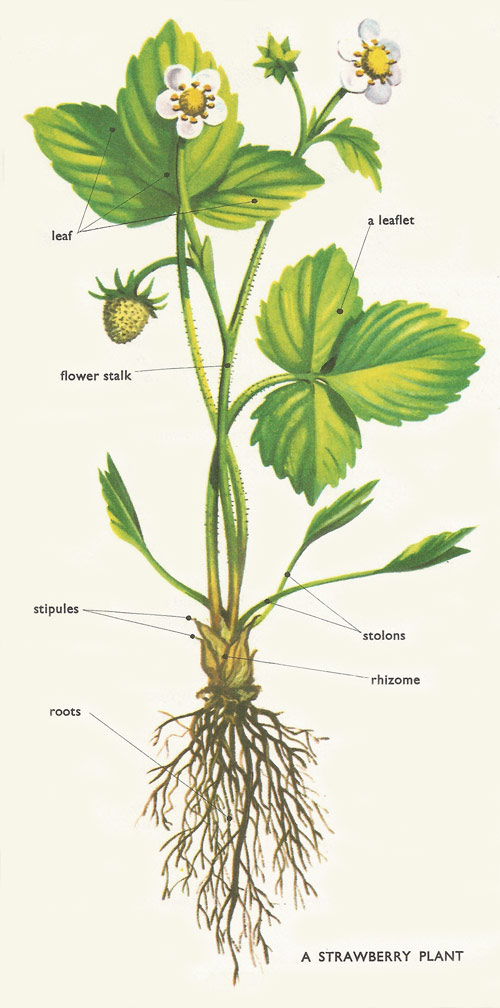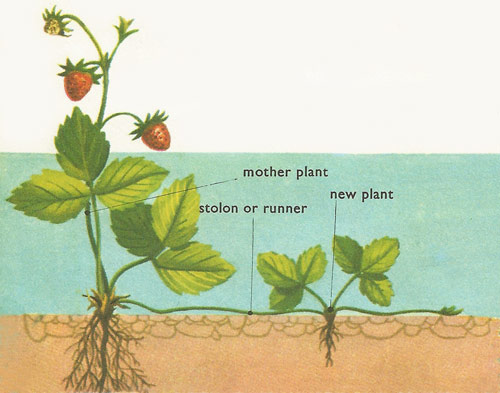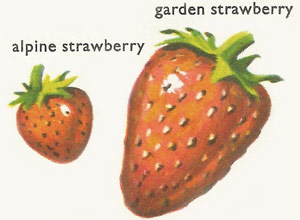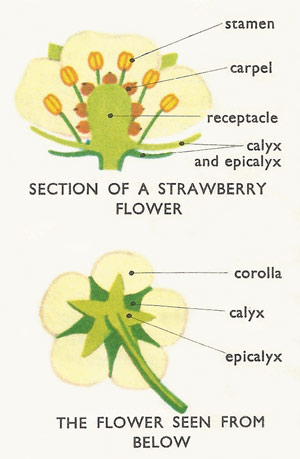strawberry

Strawberry plant.

Propagatio of a strawberry plant.
When we pick strawberries, most of us suppose we are picking the fruit of the plant. But a botanist would know that we are picking not the fruit but the receptacle – that is, the swollen base of the flower. Of course, the strawberry is a fruit in everyday speech, but it is worth remembering that in its structure and development it is a very peculiar one.
Kinds of strawberry
We'll consider three kinds of strawberry here, starting with the little wild strawberry, Fragaria vesca. This is a common woodland plant, and its fruit is pleasant to eat but so small that it is hard work picking even a handful of them.
The alpine strawberry, a variety of Fragaria vesca from the mountains of southern Europe, is sometimes cultivated for its fruit. It is a climbing plant and continues flowering and fruiting from May until the autumn. The fruit is larger than that of the British wild variety, but still much smaller than that of the garden variety.
The garden strawberry is a hybrid plant, which originated in France in the 18th century by the crossing of two American species. It has since been improved by selection, and a large number of varieties have been produced. The name 'strawberry' refers to the practice of putting straw around the plants to lift the fruit off the ground and keep it clean. Remember that, although the plants are hardy, the flowers cannot stand frost. If there is a frost warning when strawberries are in bloom, they should be covered.
 |
Generally speaking, strawberries are excellent fruit but some people cannot eat them. In such individuals the fruit causes severe skin eruption or urticaria, and sometimes stomach upset as well
The plant
The strawberry is a herbaceous perennial plant belonging to the family rosaceae. Look at the labeled illustration on the upper right. The roots are fibrous; the stem does not rise above the ground and is therefore classed as a rhizome, a term meaning an underground stem. From this grow the leaves, the flower stalks, and also the stolons or runners, which are stems that creep along the surface of the ground. The leaves are of the type known as trifoliate, because each one consists of three separate parts called leaflets.
Now for the flower. This has a calyx of five sepals and also an epicalyx of five bracts, looking like an extra calyx, a corolla of five petals and numerous stamens and carpels; all of these are borne on the swollen tip of the flower stalk, which is called the receptacle. It is this receptacle which, after fertilization, swells and forms what we call the fruit. The true fruit, from the botanical point of view, is each of the tiny seeds on the surface of the strawberry. Each of these is a tiny one-seeded fruit of the type known as an achene.
 |
Propagation of strawberries
The runners, creeping out over the ground, put down roots at certain points known as nodes, along their length, and then leaves grow up from the same points, so that little plants are formed. When the young plant is well established, the runner can be cut, and the new plant can then be transplanted wherever it is required.


